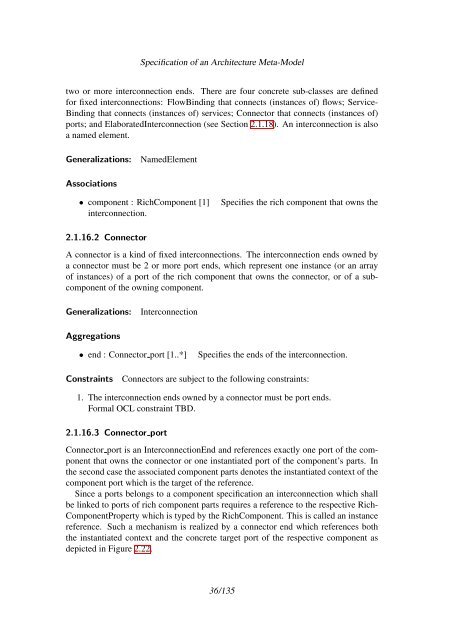Specification of an Architecture Meta-Model - SPES 2020
Specification of an Architecture Meta-Model - SPES 2020
Specification of an Architecture Meta-Model - SPES 2020
You also want an ePaper? Increase the reach of your titles
YUMPU automatically turns print PDFs into web optimized ePapers that Google loves.
<strong>Specification</strong> <strong>of</strong> <strong>an</strong> <strong>Architecture</strong> <strong>Meta</strong>-<strong>Model</strong><br />
two or more interconnection ends. There are four concrete sub-classes are defined<br />
for fixed interconnections: FlowBinding that connects (inst<strong>an</strong>ces <strong>of</strong>) flows; Service-<br />
Binding that connects (inst<strong>an</strong>ces <strong>of</strong>) services; Connector that connects (inst<strong>an</strong>ces <strong>of</strong>)<br />
ports; <strong>an</strong>d ElaboratedInterconnection (see Section 2.1.18). An interconnection is also<br />
a named element.<br />
Generalizations: NamedElement<br />
Associations<br />
• component : RichComponent [1] Specifies the rich component that owns the<br />
interconnection.<br />
2.1.16.2 Connector<br />
A connector is a kind <strong>of</strong> fixed interconnections. The interconnection ends owned by<br />
a connector must be 2 or more port ends, which represent one inst<strong>an</strong>ce (or <strong>an</strong> array<br />
<strong>of</strong> inst<strong>an</strong>ces) <strong>of</strong> a port <strong>of</strong> the rich component that owns the connector, or <strong>of</strong> a subcomponent<br />
<strong>of</strong> the owning component.<br />
Generalizations: Interconnection<br />
Aggregations<br />
• end : Connector port [1..*] Specifies the ends <strong>of</strong> the interconnection.<br />
Constraints Connectors are subject to the following constraints:<br />
1. The interconnection ends owned by a connector must be port ends.<br />
Formal OCL constraint TBD.<br />
2.1.16.3 Connector port<br />
Connector port is <strong>an</strong> InterconnectionEnd <strong>an</strong>d references exactly one port <strong>of</strong> the component<br />
that owns the connector or one inst<strong>an</strong>tiated port <strong>of</strong> the component’s parts. In<br />
the second case the associated component parts denotes the inst<strong>an</strong>tiated context <strong>of</strong> the<br />
component port which is the target <strong>of</strong> the reference.<br />
Since a ports belongs to a component specification <strong>an</strong> interconnection which shall<br />
be linked to ports <strong>of</strong> rich component parts requires a reference to the respective Rich-<br />
ComponentProperty which is typed by the RichComponent. This is called <strong>an</strong> inst<strong>an</strong>ce<br />
reference. Such a mech<strong>an</strong>ism is realized by a connector end which references both<br />
the inst<strong>an</strong>tiated context <strong>an</strong>d the concrete target port <strong>of</strong> the respective component as<br />
depicted in Figure 2.22.<br />
36/135
















